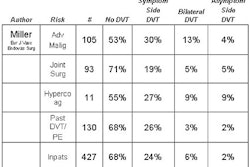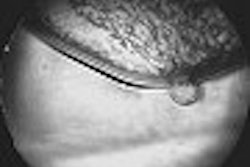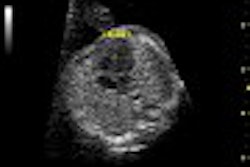The shape of a child’s bladder can significantly affect the accuracy of ultrasound estimates of bladder volume. As a result, correction coefficients should be applied accordingly, say Croatian researchers.
"Ultrasonographic classification of bladder by shape into five categories and applying correction coefficient to the most closely resembling shape can significantly reduce estimation error in bladder-volume measurements," said Dr. Boris Brkljacic of the department of diagnostic and interventional radiology at the University Hospital Dubrava in Zagreb. He presented his group’s study at the 2003 Leading Edge in Diagnostic Ultrasound conference in Philadelphia.
To evaluate the impact of bladder shape and to calculate formulas for ultrasound estimation of volume for different bladder shapes, the researchers performed ultrasound on 146 children ranging in age from nine months to 17 years (median 7.9 years) referred for urodynamic investigation.
A single scanner with a 5-MHz curved-array transducer was used, Brkljacic said. The children were scanned in the supine position, with the transducer positioned in the midline above the pubic symphisis. The bladder was visualized in the transverse and sagittal planes.
Three bladder diameters were measured, and shapes were characterized as round, ellipsoid, cuboid, triangular, and undefined. Immediately after ultrasound, urine was collected by voiding or by catheterization, and the volume was measured, he said.
The bladder was then again scanned to assess residual volume, whereupon the bladder was drained. Total volume was then determined. The researchers then calculated correction coefficients (k) for the whole sample, and for each bladder shape using linear regression analysis.
They also studied absolute differences of predicted value from regression equations for the whole sample, as well as for the respective bladder shapes. In addition, the researchers studied how a correction coefficient (k) of 0.5 (commonly used in ultrasound textbooks) would have performed, Brkljacic said.
Twenty-three percent of the children had a round bladder shape, with 25% having a cuboid shape and 21% an ellipsoid shape. Twenty-five percent had a triangular shape and 6% had an undefined shape.
The researchers determined that the correction (or regression) coefficient for the whole sample was 0.66 (SE = .011). Round bladders had a k of 0.561 (SE = 0.013), while cuboid bladders had a k of 0.923 (SE = 0.012). The study team calculated that ellipsoid bladders produced a correction coefficient of 0.802 (SE = 0.006), triangular bladders a correction coefficient of 0.623 (S.E. = 0.007), and bladders with undefined shape a correction coefficient of 0.749 (S.E. = 0.048).
The specific correction coefficients produced significantly lower mean percentage errors compared with simply applying a correction coefficient (k) of 0.5, Brkljacic said.
"Only 23% of children had round bladders that had the smallest k (0.56), which was close to the often-recommended k of 0.5 in literature," he said. "Using k of 0.56, the bladder volume would have been underestimated in as many as 77% of our patients."
By Erik L. RidleyAuntMinnie.com staff writer
August 29, 2003
Related Reading
Dynamic US offers high sensitivity for pediatric bladder exam, July 28, 2003
Copyright © 2003 AuntMinnie.com



















